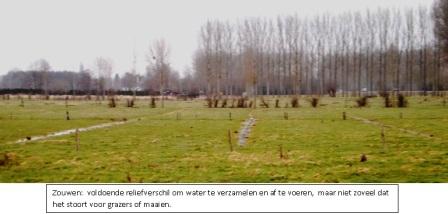Drainage or dewatering is the removal of water over and through the ground in order to decrease the groundwater level. In wet meadow or forest shallow ditches (swales) were dug for this which led at the plot boundaries in deeper canals. Nowadays for this with coconut (machine) wrapped perforated pipes are buried. You can also fill a ditch with fagots or gravel (with bitumen cloth as soil retaining walls around it). It will silt and clog again. Also swales and canals should be cleaned or deepened every few years.
 (A swale is wide and shallow, slight trough with very blunt edges. You can even mow in it. It can be grazed and run over without stumbling. Only at much precipitation there is some slowly runoff water in it. The higher part remains dryer and passable. They were used in pastures and woods.)
(A swale is wide and shallow, slight trough with very blunt edges. You can even mow in it. It can be grazed and run over without stumbling. Only at much precipitation there is some slowly runoff water in it. The higher part remains dryer and passable. They were used in pastures and woods.)
Rabats are raised plant strips for trees in originally wet areas to create more rootable depth of the forest floor. With the soil from the long ditches that are dug for drainage, intermediate strips (usually narrow, up to about 2 meters wide) are raised. This creates a pattern that forms a bunch of rabbats. The method was already mentioned in 1799.
Rabats are sometimes used as an orchard or osier fields, and sometimes also as a narrow garden or flower bed.
(The word also refers to a semicircular groove or rebate, and to the standard discount a trader receives.)
A meadow or wetland is the toponym (field name) to indicate grassland plots in a stream valley.
In stream valleys swales were also used to irrigate and bring minerals in the hayfield. There was no fertilizer, and livestock remained predominantly in the stable (or was herded). Brooks were dammed up, and the overflow was used to transfer (the ”watering’) (alternating) nutrients (which were removed by haying) to the plot.
